Exploring the Avian Vocalists: Types of Talking Pet Birds
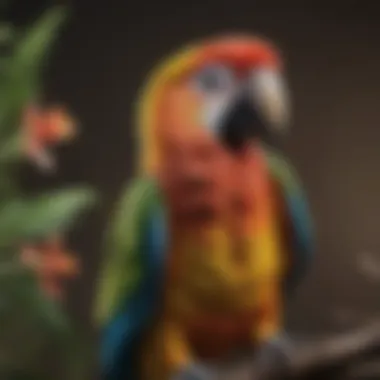
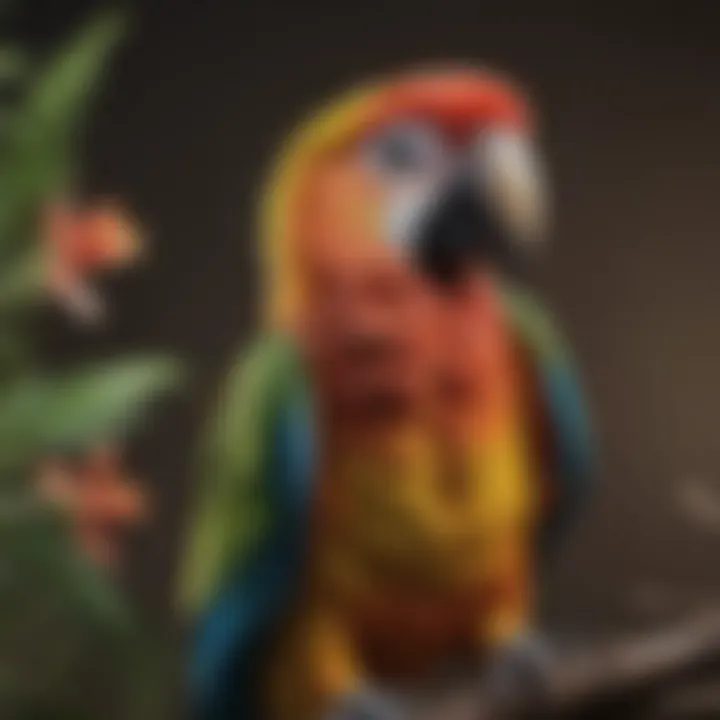
Intro
The world of pet birds is captivating and diverse. Among the many traits that draw enthusiasts to these avian companions, one of the most remarkable is their ability to mimic human speech. This article explores various species known for their talking potential, delving into their unique vocal characteristics and communication abilities. By providing comprehensive care tips, behavioral insights, and nutrition guidelines, we aim to equip current and aspiring bird owners with the knowledge needed to foster healthy, interactive relationships with their feathered friends.
Care Tips
Taking care of talking pet birds requires attention to daily routines and overall well-being. Here are important care tips to follow:
Daily Care Routines
Establishing a consistent daily routine is fundamental. This includes:
- Providing fresh water and food every day.
- Allowing time for social interaction. Birds thrive on companionship.
- Ensuring regular out-of-cage time for exercise and exploration.
- Observing any changes in behavior that might indicate stress or discomfort.
Cage Setup and Maintenance
The cage is the bird's home and must be safe and suitable. Key aspects include:
- Choosing the right size for your bird species; larger birds need more space.
- Providing perches at different levels and materials to encourage foot health.
- Including toys to stimulate mental engagement.
- Regularly checking for any damages or wear.
Hygiene and Cleaning Practices
Maintaining cleanliness plays a vital role in a bird's health. Follow these practices:
- Clean the cage bottom and remove soiled bedding regularly.
- Wash food and water dishes daily to prevent bacterial growth.
- Disinfect the cage and toys periodically.
Seasonal Care Adjustments
Birds may require different care based on the seasons. Consider:
- During winter, provide extra warmth and avoid drafts.
- In summer, ensure adequate hydration and shade from direct sunlight.
- Adjust indoor humidity levels as needed for comfort.
Behavioral Insights
Understanding bird behavior is key to effective communication. Here are insights into avian behavior:
Understanding Bird Body Language
Birds communicate a lot through their body language. Familiarize yourself with:
- Wing flapping as a sign of excitement or energy.
- Head bobbing or tilting indicates curiosity or interest.
- Feather fluffing can signal contentment or, sometimes, fear.
Common Behavioral Issues and Solutions
Some common problems include:
- Excessive screaming or biting.
- Feather plucking which may indicate stress or boredom. Effective solutions include engaging them more and providing enrichment.
Positive Reinforcement Techniques
Using rewards to encourage desired behaviors works well. Techniques include:
- Offering treats for mimicking or interaction.
- Praising vocalization or tricks when performed.
Social Interaction Needs
Birds are inherently social creatures. They benefit from:
- Regular interaction with their owners or other birds.
- Establishing routines that include play and socialization.
Nutrition Guides
A well-rounded diet is essential for a talking bird's overall health and ability to vocalize. Consider these elements:
Essential Diet Components
A typical diet might include:
- High-quality pellets designed for your species.
- Fresh fruits and vegetables daily for vitamins.
- Grains and seeds, but in moderation.
Safe and Toxic Foods
Some foods are beneficial while others are harmful. Keep in mind:
- Safe options: apples, carrots, broccoli, millet.
- Toxic foods include chocolate, caffeine, and avocado.
Supplements and Treats
Occasional treats can be helpful. Choose:
- Bird-safe supplements to enhance nutrition.
- Natural treats like nuts or seeds.
Feeding Strategies for Different Species
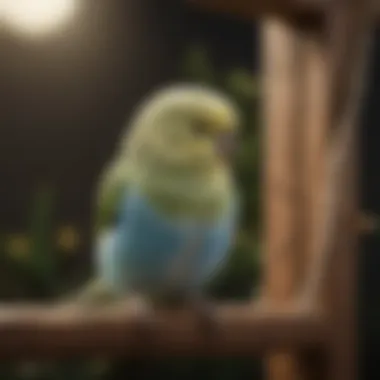
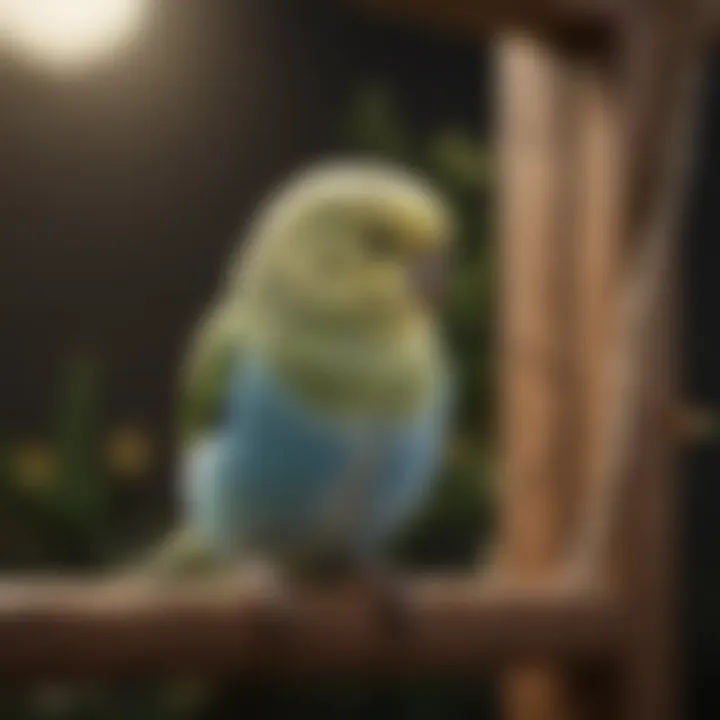
Each bird has specific needs. Research dietary requirements based on species. Larger parrots, for example, often require more protein than budgies.
Wellness and Health
Maintaining a bird's overall health is essential. Routine wellness checks involve:
Routine Health Checkups
Regular veterinary visits help in early detection of any health issues. Look for avian vets with experience.
Identifying Symptoms of Illness
Being observant is crucial. Symptoms include:
- Changes in behavior or appetite.
- Unusual droppings or excessive sleeping.
Preventative Care and Vaccinations
Wellness shots and treatments can prevent many diseases. Consult with a veterinarian regarding vaccination schedules.
Mental and Emotional Well-being
Emotional health impacts vocalization. Provide stimulation through:
- Daily interaction and mental challenges.
- Safe toys and environmental enrichment.
Enriching Activities
Engagement goes beyond routine care. Birds need stimulating activities for their mental health:
Toys and Playtime Ideas
Consider a variety of toys:
- Chewing toys for beak health.
- Puzzle toys to challenge their mind.
Training and Tricks
Training promotes bonding. Simple tricks include:
- Teaching to speak new words with repetition.
- Teaching to wave or do simple commands.
Outdoor Activities and Interaction
Supervised time outside can be beneficial. Birds enjoy:
- Fresh air and sun, which may enhance mood.
- Natural sounds that can stimulate vocalization.
DIY Projects for Mental Stimulation
Creating homemade toys can be cost-effective and fulfilling. Use safe materials:
- Cardboard tubes, untreated wood, and non-toxic fabrics.
Understanding Vocal Mimicry in Birds
Vocal mimicry in birds is a remarkable phenomenon that has garnered attention from avian enthusiasts and researchers alike. It is essential to understand this topic as it lays the groundwork for exploring which pet bird species are capable of talking. This understanding can enhance the experience of bird owners and aspiring bird owners.
The ability to mimic sounds serves several functions for birds. This ability can be used for communication between birds, social interactions within flocks, or even territorial claims. Different species utilize vocal mimicry differently, which contributes to their adaptability in various environments. For pet owners, knowing how their birds communicate can deepen the bond between human and avian companions.
The Science Behind Bird Vocalization
Bird vocalization relies on complex physical structures and neurological processes. Birds have a specialized vocal organ called the syrinx. This organ is versatile, allowing birds to produce a wide range of sounds. Unlike mammals, birds can control the muscles associated with the syrinx independently, enabling them to create intricate vocal patterns.
In addition, birds have a well-developed auditory processing system, allowing them to learn and imitate sounds from their environment. This includes human voices, household noises, and even other animal calls. The combination of anatomical features and mental faculties provides birds with the remarkable capacity for vocal mimicry.
Research has shown that certain species are particularly adept at learning sounds. For instance, African Grey Parrots are renowned not only for their ability to mimic human speech but also for their understanding of context.
Evolution of Mimicking Abilities
The evolution of vocal mimicry in birds is a topic of ongoing research and fascination. It is believed that mimicking abilities evolved as a social adaptation. In the wild, being able to imitate the calls of other species can help birds fit into various social structures. For example, mimicking the calls of predators may contribute to survival by warning other birds of danger.
Some studies suggest that the evolutionary pressure on vocal mimicry is linked with cognitive development in birds. More intelligent species demonstrate advanced mimicry skills. This connection indicates that those birds capable of intricate vocalizations may also exhibit enhanced problem-solving capacities.
In summary, understanding vocal mimicry in birds provides crucial insights into the reasons behind their unique vocal talents. It illustrates not only how birds communicate but also their adaptability and intelligence. As we move further into discussing specific species, knowing these details prepares bird owners to foster enriched environments where their avian companions can thrive.
Popular Species of Talking Birds
Understanding the different species of talking birds is key to appreciating their vocal capabilities and attributes. These birds not only bring joy through their ability to mimic human speech but also foster a unique companionship. Knowledge of the various species can guide potential bird owners in making informed choices. This section highlights popular talking birds, elaborating on their vocal skills and the factors that contribute to their talking abilities. Care requirements, personality traits, and training methods also play crucial roles in the overall experience of owning these avian vocalists.
African Grey Parrots
Intelligence and Vocabulary
African Grey Parrots are renowned for their exceptional intelligence and vast vocabulary. Their capacity for learning words and phrases is impressive, often amassing hundreds of words over time. This intelligence stems from their innate problem-solving skills, which allow for more cognitive engagement with their human owners. Their ability to understand context and use words appropriately elevates their status as one of the most sought-after talking birds.
However, the commitment required to train and socialize an African Grey may be more demanding due to their high intellect.
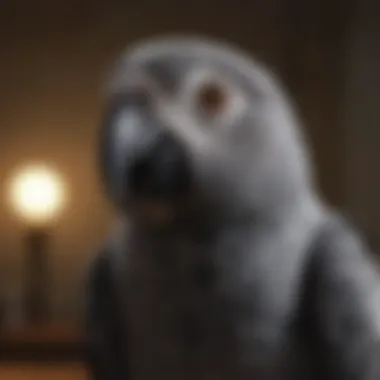
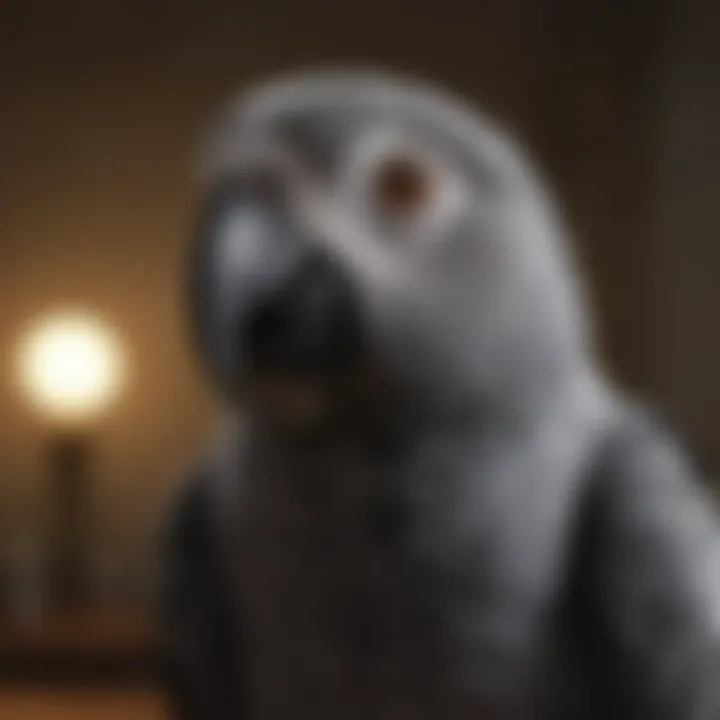
Behavior and Interaction
The behavior of African Grey Parrots also significantly influences their talking ability. These birds are social creatures and thrive on interaction, which is crucial for verbal development. They readily respond to voice tone and body language, making them sensitive companions. Building a strong bond is vital, as neglect can lead to behavioral issues, stifling their vocalization potential. The interactive nature of African Greys enriches their environment and encourages communication, yet it requires dedication from their owners.
Amazon Parrots
Vocal Talents and Personality Traits
Amazon Parrots possess distinct vocal talents along with dynamic personalities. They have a knack for clarity and often mimic sounds with an impressive degree of accuracy. Known for their outgoing nature, they are sociable and engage well with people, making them appealing as companion birds. Their vibrant temperament encourages playful interaction, contributing to a happy household. However, some may find their loud vocalizations overwhelming.
Care Requirements
Owning an Amazon Parrot involves understanding their care needs. A balanced diet and mental stimulation are essential for their health and well-being. Providing toys and opportunities for social interaction can prevent boredom and encourage vocalization. Their lively behavior can require considerable attention, which is an important aspect to consider for potential owners.
Budgerigars (Budgies)
Learning Capacity
Budgerigars are often underestimated in their talking ability. Their learning capacity is notable; they can pick up a variety of words and phrases with ease. This makes Budgies a popular choice for beginner bird owners who want a talking pet. Their smaller size and generally manageable dietary needs add to their appeal. However, some Budgerigars may not develop as large a vocabulary as their larger counterparts.
Socialization Needs
Budgies are social birds that thrive in interactive environments. They require regular socialization and can become withdrawn without sufficient engagement. This need for companionship can encourage vocalization, as they often mimic sounds to attract attention. However, it can also create frustration if not met, highlighting the need for a dedicated and time-rich ownership.
Cockatiels
Vocalization Patterns
Cockatiels are known for their unique vocalization patterns, which include whistles and chirps. Their sounds can be delightful, though they may not replicate human speech as effectively as larger parrots. Their charming melodies add a pleasant ambiance to a home, appealing to many bird enthusiasts. It should be noted, however, that the less extensive vocabularies may not meet the desires of those seeking a highly verbal companion.
Training Tips
Training Cockatiels can be reasonably straightforward, especially when employing positive reinforcement techniques. Encouraging vocalization through rewards is effective. Consistency in training routines helps reinforce their learning. They respond well to interactions, but it is important to remain patient as they progress at their own pace.
Quaker Parrots
Unique Speech Abilities
Quaker Parrots are distinguished by their unique speech abilities, often capable of clear, articulate phrases. They tend to form strong bonds with their owners, making their vocalizations even more meaningful. Their cheerful and sometimes mischievous nature makes them endearing companions. However, their inclination to create noise can lead to some irritation in quieter households.
Behavioral Considerations
Understanding the behavioral traits of Quaker Parrots is critical. They can be quite playful and curious, which is a positive attribute but can also lead to issues if they feel confined. Providing adequate space and stimulation is essential. If their needs are unmet, they might develop negative behaviors, impacting their overall well-being and vocality.
Factors Influencing a Bird's Ability to Talk
Understanding the factors that influence a bird's ability to talk is crucial for pet bird owners and aspiring bird parents. This knowledge not only aids in selecting the right species but also helps in creating an environment conducive to vocalization. There are several elements that impact a bird's talking capability, including age, social interactions, and effective training methods. Recognizing these aspects can improve communication between bird and owner, ensuring a fulfilling experience for both.
Age and Development
Age plays a significant role in a bird's ability to mimic sounds and develop vocal skills. Young birds, especially those from species known for talking, exhibit a greater learning capacity compared to their older counterparts. Parrots, for instance, tend to learn new words and phrases more quickly during their juvenile years. It is during this period of brain development that they can absorb information and practice vocalization patterns effectively.
Moreover, the developmental stage of the bird influences its willingness to engage and communicate. Birds that are exposed to social interactions and positive reinforcement at an early age generally become more adept at acquiring new sounds. It is beneficial to provide a variety of auditory stimuli, such as music or speech, while ensuring the environment is enriched with engaging activities.
Social Environment
The social environment of a bird is equally important in determining its ability to talk. Birds are naturally social creatures, and their interactions with humans or other birds can significantly affect their vocalization abilities. A bird that feels secure and connected is more likely to attempt to vocalize. The presence of a caregiver who regularly talks and interacts with the bird fosters a sense of trust. This rapport can motivate the bird to express itself through sounds.
Conversely, a lack of social interaction can hinder a bird's vocal development. Birds kept in solitude may not have the same motivation to talk as those engaged in social activities. It is essential to prioritize social stimulation, including regular conversations with your bird or allowing them to interact with other pet birds, as this can enhance their confidence and talking skills.
Training Techniques
Training techniques are fundamental in shaping a bird's speaking abilities. Effective training often involves consistently applying positive reinforcement methods. Rewarding a bird with treats for mimicking sounds or phrases encourages it to repeat those behaviors. Consistency in the training process is key; it ensures that the bird associates specific sounds with positive experiences, which can reinforce learning.
Utilizing repetitive phrases during training can also be beneficial. By frequently using certain words or commands, owners can help birds learn and eventually reproduce the sounds. It is advisable to start with simple words before progressing to more complex sentences.
In summary, age, social environment, and training methods are pivotal in determining a bird's capacity to talk. Understanding these elements ensures that pet owners create supportive settings for their avian companions, ultimately enhancing communication and enriching their lives.
Engaging With Talking Birds
Engaging with talking birds is a vital aspect of their care and development. Understanding how to foster communication leads to a more harmonious relationship between birds and their owners. When pet owners actively engage with their birds, it promotes mental stimulation and well-being. A bird that feels comfortable and stimulated is more likely to display its vocal talents. Moreover, if the environment encourages interaction, the bird is likely to become more confident in its vocalizations.
In addition to vocal abilities, engaging with birds enhances their emotional health. Birds are social creatures. They thrive on connection and interaction, and when owners participate in their lives actively, it benefits both parties. This connection fosters trust, which can improve behavior and facilitate communication.
Creating a Stimulating Environment
A stimulating environment is crucial for a talking bird's development. This entails providing diverse toys, perches, and play areas to keep the bird mentally and physically active. Environmental enrichment can be the difference between a stressed bird and a joyful one.
- Toys: Varied toys can promote exploration. Interactive toys encourage the bird to problem-solve and stimulate its brain, fostering vocal skills.
- Social Interaction: Regular interaction with the owner should occur. Talking, singing, and just spending time together helps build a bond and encourages the bird to communicate back.
- Space to Explore: Allowing the bird to move freely in a safe space enhances its confidence. Birds naturally want to explore, and more often they feel confident when given that opportunity.
Effective Training Methods
Training talking birds requires specific methods that promote engagement and learning. Effective training methods can lead to impressive results, enhancing communication between the bird and its owner. With appropriate techniques, birds can learn not only to mimic sounds but also to communicate in ways that enrich their interactions.
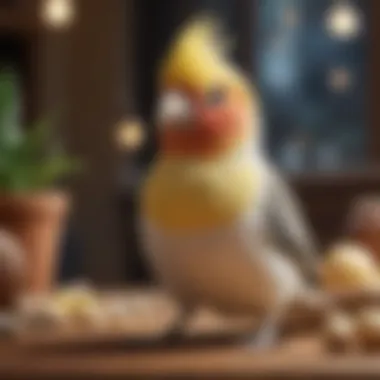
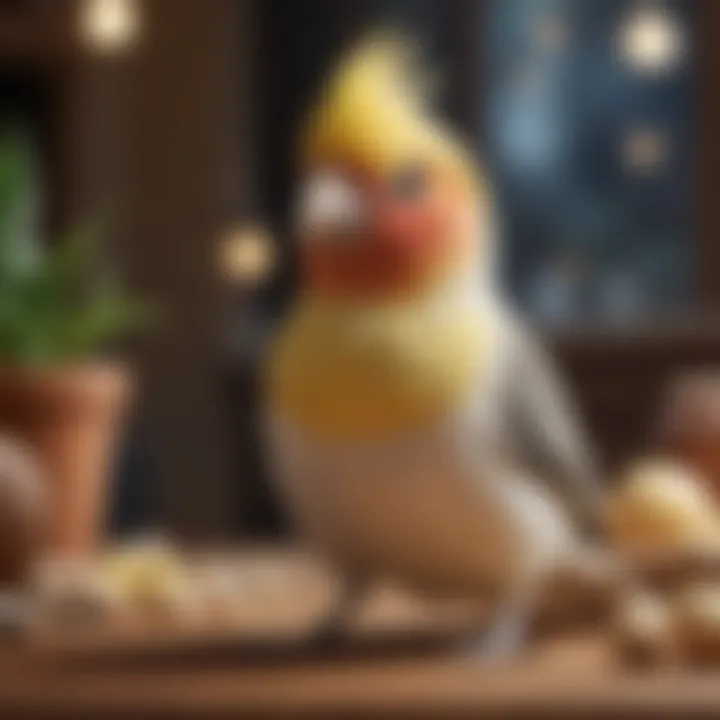
Positive Reinforcement
Positive reinforcement is a powerful tool in bird training. This method involves rewarding desired behaviors to encourage their repetition. When a bird succeeds in mimicking a word or sound, reinforcement can take form in treats or verbal praise. This technique works well because it creates positive associations with learning. Birds are likely to repeat actions that result in positive outcomes, and this fosters a love for learning.
Key characteristics of positive reinforcement include:
- Affirmation and Rewards: Using praise or treats as rewards helps birds recognize successful behavior.
- Fun and Enjoyment: Learning through positive reinforcement creates a joyful atmosphere. The bird feels motivated to engage, reducing training frustration.
While effective, this approach must be applied with care to avoid over-reliance on treats. Birds can become too focused on rewards rather than the learning process.
Consistency in Training
Consistency is paramount when training talking birds. This principle entails having a structured approach, where cues, commands, and training sessions remain the same. Consistency helps the bird to understand expectations and reduces confusion.
Key characteristics of consistency in training include:
- Predictable Environment: The bird learns better when the training context remains similar. This can be crucial for its understanding of commands and cues.
- Reinforcement of Learning: Regular sessions that are consistent help solidify learned behaviors, enhancing their language skills.
However, the requirement for consistency doesn't negate the need for variety in training. Birds may lose interest if the exercises lack diversity. Therefore, striking a balance is key to effective training and ongoing engagement.
Health and Vocal Maintenance
Maintaining the health and vocal abilities of talking pet birds is crucial for their well-being and communication skills. A healthy bird is more likely to vocalize and interact positively. This section will explore two main facets: regular veterinary check-ups and the impact of diet on vocal health.
Regular Veterinary Check-ups
Routine health check-ups with a veterinarian experienced in avian care are fundamental. These appointments help in early detection of potential health issues that may affect a bird's ability to mimic sounds and speech. Birds often hide their illnesses until they become severe, which makes regular check-ups essential for proactive care. Through examinations, veterinarians can assess the overall health of the bird’s respiratory system, which directly affects vocalization.
In addition to health assessments, your vet can provide valuable guidance on proper care, including vaccination schedules and parasite control. Remember that specialized avian vets are best suited to address the unique health needs of birds.
"Prevention is better than cure" applies in avian care as much as any other. Regular veterinary visits safeguard your bird's health and enhance its vocal capabilities.
Diet Impact on Vocal Health
The nutritional needs of talking birds are specific and rather unique. A balanced diet that includes various fruits, vegetables, seeds, and pellets plays a vital role in their vocal health. Deficiencies in certain nutrients, especially vitamins A, E, and B-complex, can alter a bird's ability to produce sound effectively or even lead to loss of voice.
In particular, vitamin A is essential for maintaining the health of the respiratory system and mucous membranes. Also, a diet rich in omega fatty acids supports overall neurological function, which is linked to learning and vocalization.
Focus on incorporating the following food items:
- Leafy greens (kale, spinach)
- Colorful fruits (berries, apples)
- High-quality pellets formulated for your bird’s species
- Variety of seeds with moderation
Ensuring that your bird receives proper hydration is also paramount. Fresh water should be available at all times, as dehydration can severely impact vocal abilities.
Common Misconceptions About Talking Birds
Understanding the misunderstandings surrounding talking birds is vital for current and potential bird owners. These misconceptions can lead to unrealistic expectations, and misinterpretation of a bird’s capabilities. This section will clarify what talking birds are and what they are not, providing clearer insight into their vocalization nuances.
What Talking Birds Are Not
Often, new pet bird owners assume that all pet birds are adept talkers. This is not the case. While species such as the African Grey Parrot are renowned for their speaking abilities, many other birds simply do not possess the same skills. Common pet birds like finches or lovebirds have limited vocal skills. They may produce sounds or chirps, but they do not mimic human speech.
Furthermore, some owners may mistakenly believe that any bird can learn to talk with enough training, which is misleading. Not all species are biologically capable of developing speech. It is important to know each species’ natural vocalization habits. Educating oneself on these aspects ensures better integration of the bird in a household.
Understanding Vocalization vs. Talking
Vocalization among birds can encompass a broad range of sounds. This includes singing, chirping, and mimicking various noises from their environment. However, speaking or talking—defined as the ability to produce understandable human language—requires specific cognitive abilities that not all birds have.
- Vocalization: Represents the range of sounds produced by birds, including calls, alarm signals, and social sounds.
- Talking: Involves mimicking human speech and words through imitation. This requires not only the physical ability to make those sounds but also a level of social interaction and learning.
"Not every beautiful sound is a conversation. Understanding this will help manage expectations."
By grasping the differences between vocalization and talking, prospective bird owners will appreciate the unique qualities of their pets. This understanding fosters a deeper relationship and can lead to fulfilling experiences with avian companions.
In summary, misconceptions about talking birds can hinder the enjoyment and fulfillment of having these remarkable pets. Understanding what talking birds truly are versus what they are not aids in setting appropriate expectations and enhances the bond between owners and their birds.
Culmination: Assessing Your Commitment
When considering the prospect of welcoming a talking bird into your home, it is imperative to assess your commitment. Owning a pet bird is much more than just providing a cage and food; it requires time, patience, and a willingness to engage in their development. This section of the article emphasizes the significance of understanding what it means to care for a vocal avian companion.
Firstly, potential bird owners must comprehend the level of interaction these creatures require. Talking birds thrive on socialization. They need daily interaction, not just to learn to talk but also for their mental well-being. Engaging with them regularly enhances their ability to mimic sounds and words, while also fostering a bond between the bird and its owner.
In addition to social interaction, taking a comprehensive look at the resources needed is crucial. From food choices that support vocal health to maintaining an enriching environment, the responsibilities are manifold. Owners must ensure that their home can accommodate the unique needs of these birds, like safe spaces for flying and play.
In summary, assessing commitment involves a deep understanding of the responsibilities associated with keeping talking birds. These creatures bring joy and companionship but require significant dedication to meet their needs fully.
Evaluating Time and Resources
Before acquiring a pet bird, one must take time to evaluate available resources. Birds require more than just food and shelter. A clear understanding of the time needed for daily interaction is vital.
Daily commitments include feeding, cleaning, and engaging with the bird. Daily training sessions are also important, especially for species known for their talking abilities. It is common for talking birds to need one-on-one time for them to develop their vocal skills effectively.
Additionally, consider the budget for essential supplies, such as toys, food, and veterinary care. A healthy diet significantly impacts a bird’s vocal abilities. Visit Encyclopedia Britannica for details on the dietary needs of pet birds and their connection to health.
Setting Realistic Expectations
Setting realistic expectations is a critical factor when deciding to bring a talking bird into your life. While many birds are renowned for their ability to mimic human speech, not all birds will talk. Factors such as species, individual personality, and training consistency all play a role.
It's essential to understand that talking is a learned behavior, not an automatic trait. Some birds may take longer to develop vocal skills than others. Owners should avoid unrealistic expectations that their bird will become a proficient talker overnight. Instead, it is more productive to focus on building a strong bond through consistent engagement and training.
Moreover, appreciate that each bird is unique. Their personalities may lead to a preference for more or less talking, and this can change over time. Therefore, patience is a virtue.















